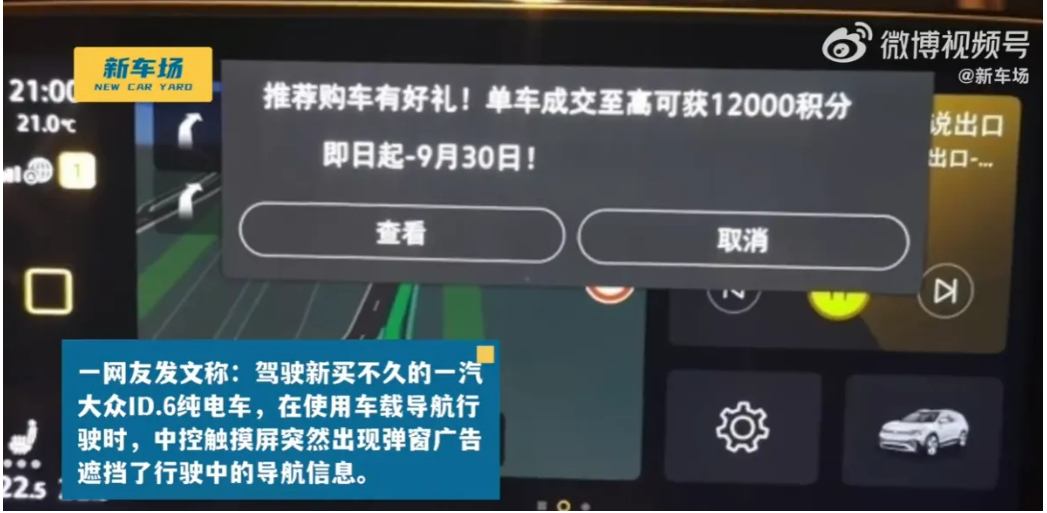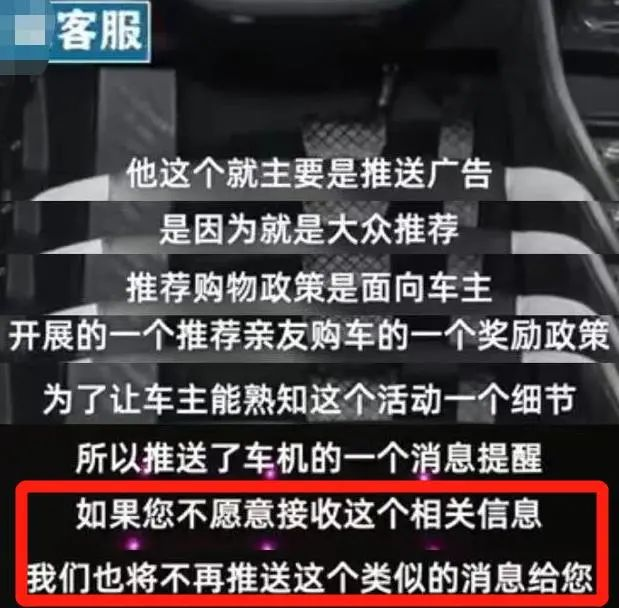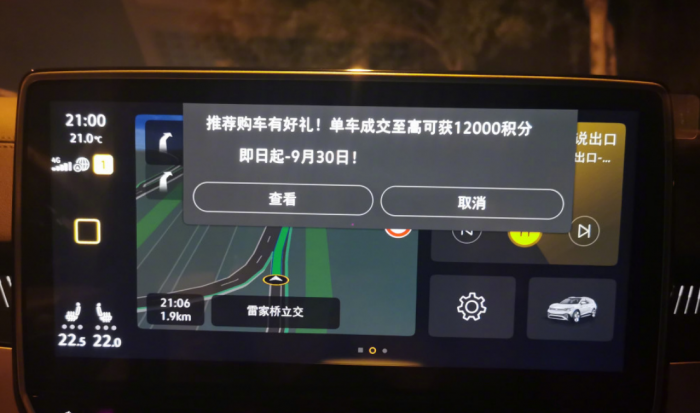Heading: Advertisement Pop-Ups in Car Navigation Systems Can be Dangerous
By: Big Eyes
Users who are still struggling with the aftermath of the “Yang Le Ge Yang” advertisement might not have expected that the next advertisement pop-up could be in their car navigation system, requiring them to free up their hands to manually close it while driving.
On September 23, a car owner driving an FAW VW ID.6 all-electric vehicle suddenly encountered a pop-up ad on the navigation interface while driving. As the pop-up ad had a large area, it almost completely obscured the navigation information of the car that was driving, and the window to close the ad was located on the side farther away from the driver.

At present, whether it is Xiaomi, Huawei, and other mobile phone manufacturers entering the automotive industry or Tesla, Geely, Nio, and others making phones, the boundary between mobile phones and smart cars is becoming increasingly blurred. As the saying goes, it’s hard to learn, easy to learn bad habits. Before these brands have learned the “true transmission” of the mobile phone system, some manufacturers have brought in the most criticized parts of the mobile phone experience.
Previously, when playing with mobile phones, we might feel annoyed when a pop-up ad appeared, but when it comes to navigation pop-ups while driving, our hearts start racing.
Imagine this:
You’re driving, humming a tune, glancing down at the navigation on the central screen and suddenly discovering that it’s been blocked halfway by a pop-up ad. Not only can’t you see the navigation information ahead, but you also have to free up one hand and stretch out half an arm to reach the “cancel” button.
During these few seconds, could you have missed an entrance or exit ramp, taken the wrong road, committed a traffic violation? Could the sudden pop-up window have distracted the driver and caused them to take their hand off the steering wheel and click “cancel,” leading to a traffic accident?
If Zhong Xuegao is the invisible ice cream assassin, then pop-up windows on car navigation during driving are the blatant “road assassins.”
When my colleagues in the media spoke to FAW Volkswagen’s customer service center as consumers to inquire about the safety concerns of pop-up ads, they received the reply: “Indeed, it is a pop-up ad promoting ‘good gifts for car purchases’ pushed by the manufacturer. If there are any activities in the future, pop-up ads will be sent out, but the frequency cannot be controlled.”
In response to the safety concerns of pop-up ads affecting driving safety, the customer service representatives displayed their “professionalism” by stating: “We will register consumers’ feedback and suggestions.”
As for what happens after registering feedback?
 The incident has been fermenting for nearly a week, and in the face of the surging public opinion, the relevant person in charge of FAW-Volkswagen apologized on behalf of the company and stated that the pop-up prompts on the car radio will be stopped immediately. “The push is not a pop-up ad, but a caring act for car owners.”
The incident has been fermenting for nearly a week, and in the face of the surging public opinion, the relevant person in charge of FAW-Volkswagen apologized on behalf of the company and stated that the pop-up prompts on the car radio will be stopped immediately. “The push is not a pop-up ad, but a caring act for car owners.”

I don’t know if car owners feel “cared for” by this push?
Car companies and netizens alike are clear about what kind of push is care and what kind is advertisement. If advertisements are pushed without the user’s consent, it may violate relevant national laws and regulations. If the push is user-oriented to bring more benefits, at least the public perception will be much better.
It’s not difficult to determine whether it’s an advertisement. After all, whether it’s maintenance reminders or brand activities, the manufacturers themselves benefit more.
Moreover, if the so-called “careful push”, which is not a pop-up ad, is reasonable and legal?
Is it legal as long as it’s not an advertisement?
Since we mentioned it, let’s take a rigorous attitude to check the relevant regulations together.
The State Internet Information Office, the Ministry of Industry and Information Technology, and the State Administration for Market Regulation jointly issued the “Regulations on the Management of Internet Pop-up Information Push Services” (hereinafter referred to as the “Regulations”), which clearly stipulates that “in no way should users be hindered or affected in closing pop-ups, and pop-up information should prominently indicate the identity of the pop-up information push service provider.”

This regulation will be implemented from September 30, 2022. Less than 48 hours left from the announcement of FAW-Volkswagen’s suspension of car radio pop-ups on the afternoon of the 28th. This time is also very accurate.
Legally speaking, if users are informed in advance of the pop-up situation and are given a simple channel to close the pop-up, the appearance of the pop-up is allowed.
However, this is for conventional Internet devices such as mobile phones and computers. For the central control screen of a car driving on the road, even if it is notified in advance and a convenient closing channel is provided, the manufacturer still needs to push it at an appropriate time. This “appropriate time” is definitely not when the vehicle is in motion and the navigation is running.
It’s highly unlikely that the relevant department thought of this when drafting the regulation, that car companies developing intelligent vehicles would be so flexible as to pop-up ads on in-car navigation systems.
The research and development personnel of car companies probably also never thought that the UI interfaces they optimized so hard and the simplified interaction logic were all designed for easier driving control and safety. But when you turn your head, your home’s push notifications block everything, resulting in vetoing the entire system.
Precision marketing: the sound of small revenue-generating tricks
From the perspective of car companies, finding new revenue channels besides vehicle sales and maintenance is becoming a new research topic.
Selling software is one way, and selling advertising space could be another.

For many traditional car industry giants, they have accumulated very large user databases through past centuries of business, and they can easily classify preferences and income of users through individual consumer car purchases.
In other words, car companies control platforms that allow for precision marketing. This platform is a precious resource for both car companies themselves and other cross-industry brands.
By targeting customers of different personality types, precise marketing and targeted advertising can not only increase the recognition of brands/activities in the shortest period, but also increase conversion rates.
Based on these circumstances, if car companies open relevant platforms to other enterprises, they can find new sources of income. Before that, car companies can also use this platform to advertise their own products and services.

Compared to all kinds of advertisements on the central control screen of navigation or the infotainment system, there is less security risk for pop-up ads on the back seat or passenger screen of electric cars. Since the back seat and passenger groups do not have to shoulder the driving task, they are more attentive to advertising.## Is there a possibility for in-car advertising to be accepted by people?
Ignoring the excessively filled emotional value centered on cursing, let’s talk about something related to actual benefits. First look at the two key questions:
Is watching advertisements an unprofitable thing for users?
If the manufacturer cannot provide a sufficiently attractive consideration, can the user refuse the manufacturer’s advertising push?
At that time, based on prior calculations, the manufacturer balanced the overall material cost of the vehicle and the advertising revenue and various commissions given to the vehicle manufacturer brought in through advertising introduction, and sent various advertisements to the rear or front passengers without affecting the safety of driving and causing excessive interruptions. The advertising-converted vehicle price is actually achievable.
At this point, the positioning of the car manufacturer may no longer be just a car manufacturer or advertising platform, but may become Meituan or Dianping, for example.

Even if we cannot see “watching ads for zero-car purchase” become a reality in the short term, in the field of shared travel, whether it is a ride-hailing platform or traditional taxi platform in various cities, can deduct a portion of the vehicle fee by allowing consumers to watch ads.
Especially for head ride-hailing platforms, they can achieve accurate push by allowing users to call different types of vehicles, providing basic information reserved at the time of registration, and even the passenger’s frequent destination. Let’s guess boldly, the value generated from this is not necessarily worse than various ads pushed to users by WeChat.

What? You said that advertisers and platforms are not planning to share profits with users and want to continue advertising?
Then forget it, see you at next year’s March 15th party.
Conclusion
Previously, when Internet brands were mass-producing cars on a large scale, netizens joked: Will we have to watch a 30-second ad before starting our car in the future?
At that time, it sounded like a black joke, but if pop-ups can be pushed even on driving navigations, what is impossible?
“Do not go gentle into that good night.”Intelligence has provided more new commercial possibilities for cars, as well as opportunities to try new innovations, but these attempts must be based on respect for cars and respect for life.
After all, unlike watching ads on a phone, driving safety allows for no room for error.
This article is a translation by ChatGPT of a Chinese report from 42HOW. If you have any questions about it, please email bd@42how.com.
